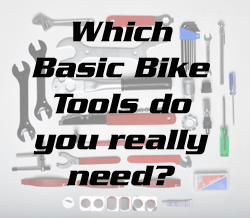You don’t always think about them, but tires are one of the most essential parts of any bicycle. Well-maintained tires keep you rolling smooth and not feeling every little bump in the road.
Any experienced rider can tell when a chain stretches and needs replacing or when their gears are grinding, but knowing when to replace your tires can be a little bit trickier. That’s why it’s important to understand just how long you’ve been riding on your current tires.
Do Mountain Bike or Road Bike Tires Wear Faster?
By their nature, bicycle tires are built to last. Whether you’re a road rider, a mountain biker, or anywhere in between, your tires have probably seen a lot of gnarly stuff. So how long can you ride them for?
It might not be a surprise, but mountain bike tires will last for significantly more miles than road bike tires. This is because they’re wider, thicker, and designed to hold up.
Miles Vs. Time
I recommend that you track your bicycle tire lifespan by miles. A 5-year-old tire that has 500 miles of riding on it is going to be in much better shape than a 6-month-old one that has 2,000 miles. Not everyone tracks their miles, though, so here are some general tips for both mileage and time.
Miles
Most road bicycle tires should be good for between 1,000 and 3,000 miles of riding, with mountain bike tires lasting 3,000 and 7,000 miles. That’s an enormous range, and that’s because there are a lot of variables at play. The average is around 2,000 and 5,000, respectively, but high-end (or more expensive) tires will last longer, and cheaper tires will last for fewer miles.
Because most riders will have more weight on the rear of the bike, you’ll likely need to change your rear tire more frequently than the front.
Time
If you’re not tracking mileage, you’ll want to track your bike’s maintenance schedule at least. Keeping track of your tune-ups is one way to go.
Most regularly-ridden tires will need to be changed every 1-3 years. But, again, that’s a big gap. If you ride weekly, plan to change every other year. If more frequently, plan on changing annually.
If you have any spare tires, those should keep for at least five years. But (and this is a big but), they have to be stored properly. A cool, dark setting like a garage works best. An overly dry or sunny spot could cause dry rot. An area with moisture could cause weak spots. Be sure to check any time you change a flat.
Tubed Vs. Tubeless
For decades and centuries, bike tires have worked in conjunction with inner tubes. The inner tube is what gets filled with air, and the bike tire protects it. More often than not, when you’re changing a flat tire, you’re swapping out the inner tube rather than the tire itself.
Recently though, tubeless tires have become more and more common and have several advantages over tubed tires. So, what does that mean in terms of how long they last?
The answer is: not too much. Tubeless tires are much less prone to flatting, so they may last a bit longer because you’re not taking them off the rim as often. However, they have the same thickness and tread as tubed tires, so the same guidelines apply for how often you should replace them.
How Do I Know That It’s Time to Change My Bike Tires?
If you’re changing an excessive number of flat tires, your tire has no or barely visible tread, or there are deep cuts anywhere, that’s generally a sign that it’s time for a change.
In addition, if you’re pumping air into your tire and it’s not holding air, that might be a bad sign. It might also mean that there’s a problem with your inner tube.
Before and after every ride, you should check both your front and rear tires for problems. Any bulges, tears, or loss of tread indicate that you will want to make the change.
What Can I Do To Make My Bike Tires Last Longer?
Let me say this off the top. Changing bike tires is an essential part of maintenance. Riding on old tires is really dangerous. At best, you’re risking damaging your rims, leading to a much more expensive repair. At worst, your tires give out, you crash, and who knows what happens from there.
All that said, though, there are some basic things you can do to take care of your tires and make sure you’re getting the most bang for your buck.
Tire Pressure
Overinflated tires will pop much more quickly. Underinflated tires are prone to pinching. Before every ride, make sure that you inflate your tires to the proper pressure. Road bike tires should be between 90-120 PSI, and mountain bikes should be between 22-35 PSI. Every tire should have a recommended range somewhere on the tire, so be sure to follow that.
Clean
Clean a bike tire? It sounds a little strange, but it works. Spinning your tires on a doormat or something similar can help get off some of the grime that builds up on tires and helps to break down the rubber. A light spin is the way to go, though. Too hard, and either the tire won’t spin, or you’ll wear the rubber.
Storage
Make sure that you’re storing your bike correctly. If you can, hang it from a bike hook to take pressure off the tires. Storing your bike on the wheels means you have to pump more air in. Storing in the sun can dry the tires out and lead to cracking.
Surface
This one’s basic but a lot of people don’t follow it. Ride your bike on the surface the tires were made for. If you’re going off-road on your road bike, your tires will need to be changed much more frequently!


